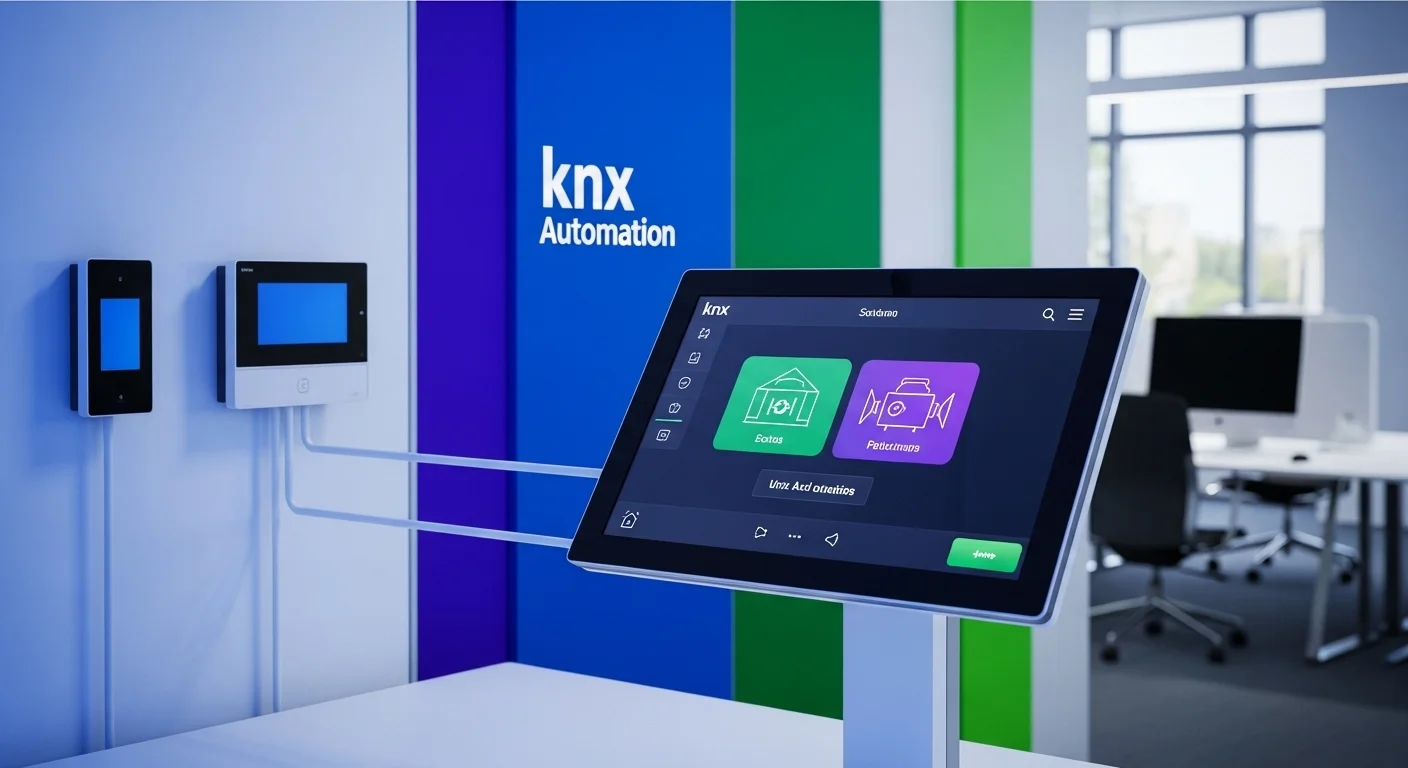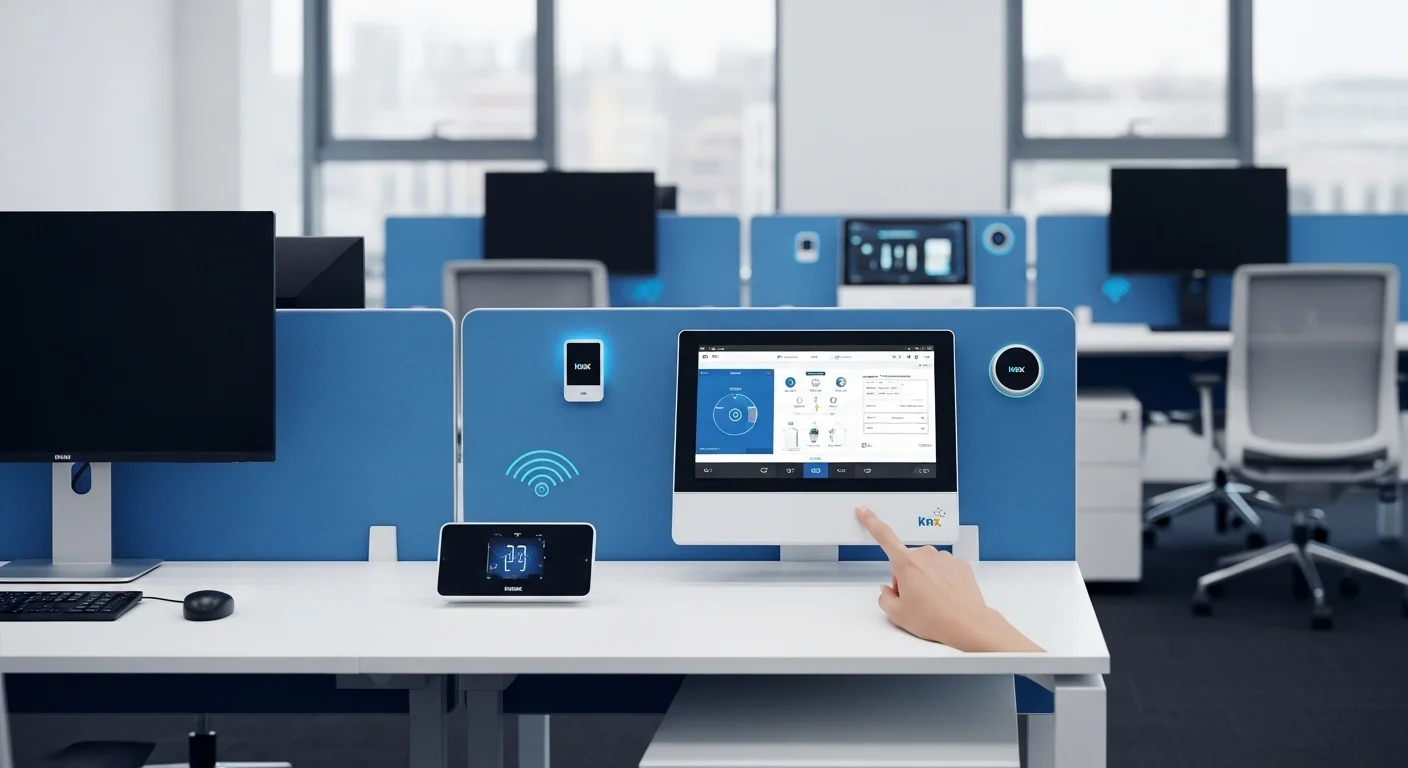KNX Automation Explained: My Guide to Smarter Homes and Buildings

Executive Summary
I've spent years in the smart building world, and I've seen countless technologies come and go. But KNX is different. It's not just another product; it's the global language that allows smart devices from over 500 different manufacturers to talk to each other perfectly. Imagine being free from being locked into one brand's ecosystem. That's the power of an open standard like KNX. For businesses, this means real, measurable savings on energy bills by making lighting and HVAC work smarter, not harder. For homeowners and tech lovers, it's a playground for creating a truly intelligent and customized living space. At its core, KNX is built for reliability. Because it's a decentralized system, there's no single point of failure. If one light switch has an issue, your heating and security systems keep running just fine. In today's world of AI and IoT, KNX is the solid, future-proof foundation you can build on, ensuring your property is smart, secure, and ready for whatever comes next.
Table of Contents
Table of Contents
- What is KNX and Why Does It Matter?
- The Core Technology Behind KNX
- Why KNX is a Game-Changer for Businesses and Enthusiasts
What is KNX Automation and Why Does It Matter?
In the world of technology, automation is the key to a more efficient, comfortable, and sustainable life. When it comes to buildings, KNX automation stands out as a true game-changer. So what is it? Simply put, KNX is a standardized, open language that lets all the smart devices in your building speak to each other. It’s not a brand you buy off a shelf, but rather the global standard (officially ISO/IEC 14543) that ensures your lights, heating, security, and energy management systems can all work together as one seamless team. The importance of a KNX automation system really comes down to one word: freedom. I've seen so many clients get frustrated with proprietary systems that lock them into a single company's products and prices. KNX is the complete opposite. With over 500 manufacturers making KNX-certified products, you have an incredible amount of choice. This competition breeds innovation and keeps prices fair. It means that whether you're planning a KNX home automation system or a massive KNX building automation project, your investment is safe for the future. You can expand, upgrade, and mix and match devices years down the line without having to rip everything out and start over.
The Core Technology Behind KNX
The story of KNX began back in the 90s, when a few forward-thinking European groups decided to create one common standard instead of competing with incompatible systems. The result was a brilliantly reliable protocol built on a decentralized model. In my experience, this is one of its biggest selling points. In a KNX system, there isn't one big 'brain' that controls everything. Think of it like a team where everyone can talk to each other directly, instead of having to go through a single boss. Each device, from a light switch to a blind motor, has its own built-in intelligence. The huge advantage here is reliability; if one component fails, the rest of the team keeps working perfectly. This distributed intelligence is what makes the system so robust. To make it even more flexible, KNX can communicate over different channels:
- Twisted Pair (TP): This is the workhorse. A dedicated two-wire bus cable (you'll recognize it by its green color) runs through the building, carrying both data and power. It's my top recommendation for new builds.
- Powerline (PL): This clever method uses the building's existing electrical wires to send data, making it a great option for older buildings where running new cables would be a nightmare.
- Radio Frequency (RF): For situations where cables just aren't an option, RF provides reliable wireless communication. It's perfect for adding a new switch to a glass wall or extending a system.
- IP/Ethernet: This lets you use your standard computer network to link different parts of a large KNX system or connect it to other building management systems.
Why KNX is a Game-Changer for Businesses and Enthusiasts
For any business, installing KNX building automation is a strategic move that pays for itself. The biggest win is always energy efficiency. I've seen clients slash their energy consumption by up to 60% with an intelligent KNX automation system. How? The system can automatically lower the blinds to block the hot afternoon sun, reducing the need for AC. It can dim lights in response to bright daylight or ensure everything is shut down in empty offices overnight. This doesn't just cut costs; it helps businesses achieve their green-energy goals. But it's not just about savings. KNX makes buildings better for the people inside. A comfortable environment with personalized lighting and temperature control can boost productivity and well-being. Integrating security and access control provides a single, easy-to-manage platform. With a single command, you can trigger a 'presentation mode' that dims the lights, lowers the projector screen, and sets the perfect room temperature.
For the homeowner and tech lover, a KNX home automation system is where the fun really begins. The possibilities are endless. Picture this: you pull into your driveway, and a 'welcome home' scene turns on the entryway lights, adjusts the thermostat, and starts your favorite playlist. When you leave, one tap of a 'goodbye' button turns off every light, lowers the heat, and arms the alarm. Controlling your home from your phone or with your voice via Alexa or Google Home is just the beginning. The real magic for an enthusiast is the deep customization. Using a special program called ETS, you or your integrator can automate KNX functions to do almost anything you can imagine, creating complex 'if this, then that' scenarios. It becomes more than a collection of gadgets; it becomes a powerful, personalized platform. In an era defined by the Internet of Things (IoT), KNX serves as the reliable and secure backbone for the truly smart buildings of today and tomorrow.

Complete Guide to KNX Technology in Business and Home Solutions
When you look under the hood of KNX automation, you find a brilliantly designed ecosystem built for ultimate reliability and flexibility. This guide will walk you through the technical side, the business case, and how it stacks up against the competition. My goal is to give both tech pros and business leaders a clear picture of what a KNX automation system can do, whether for a cozy KNX home automation setup or a sprawling KNX building automation project.
Technical Methods: System Architecture and Components
The structure of a KNX system is beautifully logical. It’s organized like a city's road network to handle projects of any size.
- Line: Think of this as a local neighborhood street. It's the basic building block, a single bus cable that connects a group of devices. Each line needs its own power supply.
- Area: This is like a main road connecting several neighborhoods. An area joins up to 15 lines using 'line couplers'. These act like traffic police, making sure messages meant for one line don't clog up the others.
- Backbone: For huge installations like a corporate campus or airport, this is the highway. A backbone connects up to 15 areas, allowing for massive networks of over 50,000 devices.
Key KNX Device Types
Every KNX network is made up of three types of devices working in harmony:
- Sensors: These are the eyes, ears, and fingertips of the system. They sense the world and issue commands. This includes everything from the light switch on your wall and motion detectors to thermostats and weather stations.
- Actuators: These are the muscles. They receive commands from sensors and take action. Dimming actuators adjust your lights, switching actuators turn outlets on or off, and valve actuators control the flow of hot water to your radiators.
- System Devices: These are the unsung heroes that make the network function. They include the power supplies that energize the bus, the couplers that direct traffic, and the programming interfaces used to set everything up.
Business Solutions and Strategic Advantages
From a business perspective, a KNX building automation system is an investment with clear, measurable returns. The applications are extensive:
- Energy Management: This is the number one reason businesses make the switch. By having HVAC, lighting, and blinds work together intelligently based on occupancy and daylight, the savings on utility bills are substantial. I've seen it make a huge difference to the bottom line.
- Operational Efficiency: Automating the building's daily routines frees up your facilities team to focus on what's important. A single operator can monitor and control the entire building from a central dashboard, reducing maintenance costs and speeding up response times.
- A Better Place to Be: In offices, hotels, or hospitals, a comfortable environment is paramount. KNX gives individuals control over their own space, which has been shown to improve productivity, guest satisfaction, and even patient recovery.
- Ready for the Future: Businesses evolve. Office layouts change. A building wing gets added. The great thing about a KNX automation system is that it can easily grow and adapt with you, protecting your initial investment for the long haul.
How KNX Compares to Other Protocols
KNX is a global powerhouse, especially in Europe, but it's not the only player in the game. Here’s my take on how it stacks up:
- Zigbee and Z-Wave: These wireless protocols are very popular in the DIY smart home scene. They're generally cheaper and easier to set up for simple tasks. However, in my professional opinion, they lack the rock-solid reliability and scalability of KNX's wired infrastructure for a large home or any commercial building.
- BACnet and Modbus: These are heavy-hitters in commercial automation, often used to control massive HVAC systems. They are excellent at what they do. In many large projects, KNX is used for controlling everything at the room level (lights, blinds, local climate) and then integrates beautifully with a BACnet BMS, creating a best-of-both-worlds solution.
- Proprietary Systems (e.g., Crestron, Control4): These companies offer a very slick, all-in-one experience. The trade-off is that you are completely locked into their hardware, software, and pricing. With KNX, the open standard gives you freedom of choice, which I believe is a far more sustainable long-term strategy.

Tips and Strategies to Get the Most from Your KNX Automation
Getting a KNX automation system right is about more than just picking parts off a list. It’s about smart planning and following best practices. Over the years, I've learned what separates a good installation from a great one. Whether you're a business planning a KNX building automation project or a homeowner dreaming up the perfect KNX home automation system, these are the tips I share with all my clients to ensure they get a system that's powerful, secure, and a joy to use.
Best Practices for Planning and Installation
A successful KNX project starts with a solid plan, long before any tools come out.
- Define Exactly What You Want: Before you even talk to an installer, walk through your space and make a detailed wish list. Think room by room: what lights do you want to control? Do you want scenes like 'movie night' or 'dinner party'? What about heating, blinds, and security? The more detailed you are upfront, the more accurate your quote will be and the smoother the project will go.
- Hire a Certified KNX Partner: This is non-negotiable. KNX is an open standard, but implementing it correctly takes serious expertise. A certified partner has been trained and tested on the ETS software and system design. Their experience is your best insurance against future headaches.
- Plan for the Future, Not Just for Today: Technology moves fast. When you're running wires, think about what you might want in five years. I once had a client who saved thousands because we ran one extra KNX cable to their garage during the initial build, making it trivial to add an EV charger years later. Running an extra cable now is cheap; opening up walls later is not. This is what makes a KNX automation system truly future-proof.
- Insist on a Logical Group Address Structure: This is a bit technical, but it's the mark of a pro. The way the system is organized in the software determines how easy it is to manage and modify down the road. A clean, well-documented structure will save you and any future technicians a world of trouble.
Advanced Integrations to Elevate the Experience
A basic KNX home automation system is great, but the real magic happens when you integrate it with other technologies.
- Voice Control: Connecting your KNX system to assistants like Amazon Alexa or Google Assistant has become a must-have. Using a simple gateway, you can say 'Hey Google, turn on kitchen lights,' and it just works. It adds a wonderful layer of convenience.
- Artificial Intelligence (AI): This is the cutting edge of KNX building automation. AI platforms can analyze data from your KNX sensors—learning when you're home, how you use certain rooms, and how the weather affects your house—to proactively optimize your environment for comfort and energy savings without you lifting a finger.
- Secure Remote Access: Cloud connectivity allows you to securely check in on and manage your KNX automation system from anywhere. It's peace of mind for homeowners on vacation and an essential tool for business owners managing multiple locations. You can check security cameras, adjust the thermostat, or get an alert if a leak is detected.
- Bringing It All Together: KNX plays well with others. It can be integrated with your home theater system, your security cameras, and advanced lighting systems like DALI. The ability to automate KNX to work in concert with these systems is what creates a truly unified and intelligent building.
Cybersecurity: A Non-Negotiable Priority
As our buildings get smarter, we have to be smart about securing them. An unprotected KNX automation system is a backdoor into your property. Thankfully, KNX has powerful security built-in.
- Demand KNX Secure: The KNX Association has developed a security standard that provides end-to-end encryption for all communication. KNX IP Secure protects data on your network, while KNX Data Secure protects it on the bus cable itself. I consider this essential, especially for any part of the system accessible from the internet.
- Lock Down Your Network: The best defense starts with your router. A huge mistake I see is people opening ports on their router for direct remote access. Don't do it. Instead, use a Virtual Private Network (VPN). Think of a VPN as your own private, armored tunnel back into your building's network. It's by far the safest way to get remote access.
- Keep Everything Updated: Just like your phone or computer, your router and KNX components need to be updated. These updates often contain critical security patches. Also, use strong, unique passwords for everything related to your network and automation system.
Expert Reviews & Testimonials
Sarah Johnson, Business Owner ⭐⭐⭐
This was a good overview of KNX, but as a business owner, I'd have loved to see a more detailed case study with real ROI numbers.
Mike Chen, IT Consultant ⭐⭐⭐⭐
Solid technical breakdown of KNX. It clarified the architecture for me, though a simpler analogy for the ETS software would have been helpful for my junior colleagues.
Emma Davis, Tech Expert ⭐⭐⭐⭐⭐
Fantastic article! As a tech specialist, I appreciated the deep dive into KNX and the comparison with other protocols. It's one of the clearest explanations I've read.



